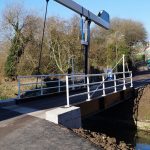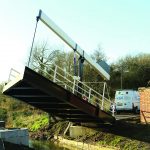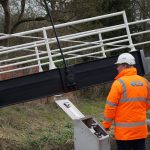New Lift Bridge extends Stroud water navigation
ECS Engineering Services has completed a complex, turnkey project to install a new lifting road bridge over the waterway that will increase the navigable length of the Stroud water navigation and improve heavy goods access to the local businesses. Stroud District Council awarded the entire project to ECS, with a tight deadline for the removal of the original bridge as well as fabrication, installation and commissioning of the new replacement bridge.

Replacing a road bridge over a water course is a complex task at the best of times, but in this case there were additional factors, such as a very restricted space in which to work and the narrow access routes that had to be used by the large equipment required for the project. In addition, this bridge does not cross the waterway at right angles, rather the road approaches at an angle that must be considered in the final design.
The original crossing was a swing bridge of wooden construction and this was replaced in the 1920s by a metal swing bridge. When the navigation was closed the bridge was fixed in the closed position and has remained limited to 8 tons capacity. The local council and the Cotswold Canal Trust have worked with a local engineer to design a new bridge that would provide improved access as well as better load capacity for the local businesses.
One of the major considerations in this project was the potential to pollute the local water course. Demolition of the existing structure and the construction of the new bridge required careful planning and special measures to ensure the waterway remained pristine throughout the project. In this case ECS protected it by ensuring that a special pontoon was constructed below the original bridge and lined with an impermeable membrane to capture all of the debris.
Once the original bridge had been removed it was necessary to install a series of reinforced concrete piles on both sides of the waterway to create the base for the new bridge. However, unexpected ground conditions and the discovery of a large amount of rotten timber, led to a change in design for the bridge foundations.
Andy Swindells, Project Manager for ECS, explains: “Normally we would have brought in a larger piling machine, but due to the limited space that wasn’t possible. In this case, the design engineers reviewed the situation and recalculated the size and distribution of the piles before work restarted. In all, 10 piles were installed, each 450mm in diameter, which formed the base for the concrete abutments on which the new bridge would stand.”
In the meantime the steel bridge deck, balance beam, support pylon and hand-rails were fabricated by ECS in its Huthwaite facility. The deck itself weighs 6 tonnes and is designed to have a safe working limit of 30 tonnes. The balance beam is designed so that the counterbalance can be fine-tuned on site by adding or removing weights. The entire construction is CE marked and classified as Execution class 3 under BS EN 1090-2.
The completed installation also incorporates road barriers, which are lowered to close off access for road vehicles while the bridge is raised, allowing the water-borne traffic to pass through.
Installation of the new bridge has removed another one of the obstacles that are gradually being cleared as part of the renovation of the waterways through Stroud. The additional benefit in this case is the increased weight capacity and improved access for local businesses.
- ECS Engineering Services has completed a complex, turnkey project to install a new lifting road bridge over the waterway that will increase the navigable length of the Stroud water navigation and improve heavy goods access to the local businesses.
- The steel bridge deck, balance beam, support pylon and hand-rails were fabricated by ECS in its Huthwaite facility.
- The completed installation also incorporates road barriers, which are lowered to close off access for road vehicles while the bridge is raised, allowing the water-borne traffic to pass through.








